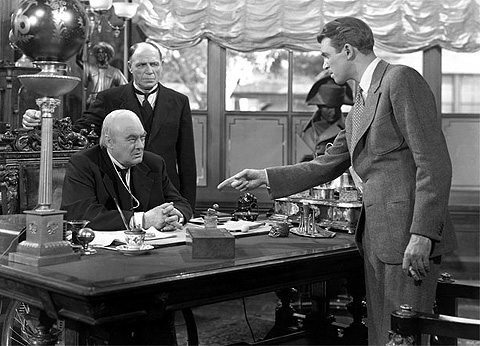by James H Kunstler on 18 December 2006 in www.kunslter.com
It's a Wonderful Life, Frank Capra's 1946 Christmas card to America, is full of strange and bitter lessons about who we were and who we have become. It also illustrates the perversity of history -- the fact that things sometimes end up the opposite of the way we expect.
The movie concerns the life and career of one George Bailey (Jimmy Stewart) and his neighbors in the prototypical main street town of Bedford Falls. The story's arc runs roughly from about 1910 to the 1946 "present." By the 1920s, young George yearns to break free of the "crummy little town" (as he calls it), but circumstances keep him bound to it through the years, and to the family business, a little local "building and loan" bank of the
kind that also used to be called "thrifts" and later "savings and loans," now extinct institutions.
Bailey Building and Loan gets whipsawed by the boom of the 1920s and then the Great Depression. World War Two comes and goes. Over the decades, George is bedeviled by the town villain, scheming rival banker Mr. (no first name) Potter (Lionel Barrymore), who is always trying to shut down or take over Bailey Building and Loan.
Eventually, Mr. Potter gets the better of George, who attempts suicide, but is saved by an avuncular guardian angel named Clarence, who shows George how much worse off his town (and, by extension, the world) would be if George had never been born. The rest is George coming to his senses on Christmas Eve, amid caroling and bell ringing, realizing how wonderful all the vicissitudes of small town life, and family, and banking really have been.
It's a splendid, heartwarming movie in many ways (and I am not being facetious). It was released a year after the awful ordeal of World War Two ended -- which itself had followed the decade-long tribulation of the Great Depression. America was weary but victorious. Democracy and decency had triumphed over manifest evil -- but the memory of all that hardship lingered on. In 1946, we were a chastened, earnest, prudent, generous, and quietly confident nation of heroes who
had managed to lick hard times and Hitler.The Jimmy Stewart portrayal of George Bailey was supposed to embody all the home front virtues in our national character that made victory possible.
Here's the weird part though. The main business of Bailey Building and Loan was financing the first new suburban subdivisions of the automobile age. In one of the movie's major set pieces, George Bailey opens Bailey Park, a tract of car-dependent cookie-cutter bungalows, and turns over the keys to the first house to the Italian immigrant Martini family. Had the story continued beyond 1946 into, say, the 1980s, (with George Bailey now a doddering Florida golfer), we would
have seen the American landscape ravaged by suburban development, and the main street towns like Bedford Falls gutted and left for dead. That was the perverse outcome of George Bailey's good intentions. We also would have witnessed the Savings and Loan Crisis of the late 1980s, when changes in federal regulation opened the door to an orgy of looting and grift (acted out largely in suburban development scams) so extravagant that a quarter-trillion dollar federal bail-out
was eventually required to cauterize the economic infection.
At a crucial point in the story, Clarence the guardian angel takes George Bailey on a tour of Bedford Falls as-if-George-had-never-been-born. Only the town is named Pottersville now. Main Street is lined with gin mills, strip clubs, and dance halls instead of wholesome banks, groceries, and pharmacies. (Oddly, casinos are absent, because in 1946 we lacked the vision to see how truly demoralized our nation could get.) Prostitutes ply the busy sidewalks. Now the weirdest
thing is that Pottersville is depicted as a busy, bustling, lively place -- the exact opposite of what main streets all over America really became, thanks to George Bailey's efforts -- a wilderness of surface parking, from sea to shining sea, with WalMart waiting on the edge of every town like Moloch poised to inhale the last remaining vapors of America's morale. Frank Capra could imagine vibrant small towns turning their vibrancy in the direction of vice -- but he couldn't
imagine them forsaken and abandoned, with the shop fronts boarded up and the sidewalks empty, which was the true tragic destiny of all the Bedford Falls in our nation.
Most ironically, today America's favorite main street town, Las Vegas, is Pottersville writ large, and most Americans see absolutely nothing wrong with it.
How wonderful is that?
|
